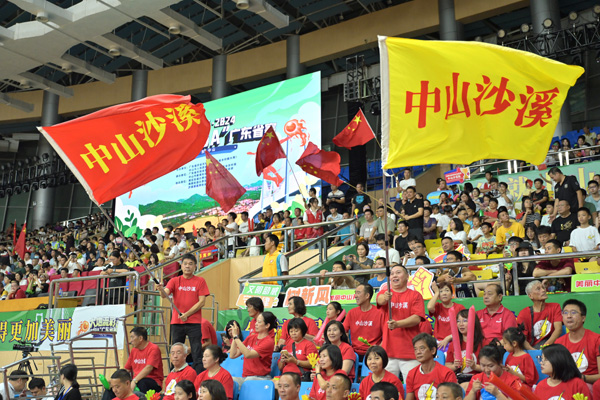Basketball games help to shine light on villages
Basketball enthusiasts recently enjoyed an extravaganza in Guangdong province, as the 2024 national rural basketball tournament (Guangdong) concluded on Sept 15 in Shaxi town, Zhongshan city.
Over eight days, 23 teams from 21 cities across the province competed in 63 matches, with the Zhongshan Shaxi team and the Zhongshan Guzhen team emerging as the champion and runner-up, respectively.
This year's event blended sports with showcases of intangible cultural heritage, local delicacies and agricultural product exhibitions. It was deemed a shining brand of Guangdong's "harmonious and beautiful villages" and a new force accelerating the advancement of the high-quality development project for Guangdong's counties, towns and villages.
During the tournament, Zhongshan organized a series of intangible cultural heritage performances, including the drunken dragon dance and qilin (a legendary beast in Chinese mythology) dance. Additionally, the city set up exhibition areas for products from various cities across Guangdong and curated several premium rural cultural tourism routes to leverage the event's influence in promoting rural cuisine and scenic spots.
The event not only allowed villagers to experience the joy of sports but stimulated the development of local catering industries such as dining, accommodation and tourism, creating more job opportunities.
Also, more than 100 rural livestreamers from across the province, joined by four foreign livestreamers, turned their cameras to Zhongshan. Through their lenses, the basketball matches, picturesque rural landscapes, traditional cultural performances and distinctive Lingnan cuisine were showcased to a nationwide audience.
Their live broadcasts showed off the charm of beautiful rural areas and enhanced the recognition of Guangdong's special agricultural products, broadening the path for rural vitalization in the province.

Basketball fans wave the flag for the Zhongshan Shaxi team at the provincial final. MIAO XIAOJIAN/FOR CHINA DAILY
In Guangdong, rural basketball enjoys great popularity among the grassroots. Through initiatives like the farmers' fitness project, the province established basketball courts in all administrative villages more than a decade ago.
Furthermore, it has organized province-wide sports events like the 10,000 villages basketball tournament, which promoted sports facilities in villages and strengthened the cultivation of talented athletes.
Taking Shaxi as an example, its basketball tradition dates back to the 1930s, earning it the title of "basketball town" in Zhongshan. Statistics show that nearly 300 local athletes have participated in each national rural basketball tournament in recent years, with up to 70 percent of the local population caring about the events.
Experts said that cultural vitalization is the soul of rural vitalization, essential for enhancing social civilization and fostering a new atmosphere. They noted that integrating sports with rural areas enriches cultural life and enhances cohesion, outlining a diverse and multifaceted path to rural vitalization.
Customs, folk songs and dances, and agricultural skills are excellent rural cultural resources. Making good use of these resources and promoting the deep integration of community sports with local culture and ethnic characteristics can inject continuous momentum into rural vitalization.
This approach helps to create a strong atmosphere for the whole society to care about constructing livable and beautiful villages, and promotes high-quality development in rural sports, experts said.
According to the Guangdong rural construction action plan issued in the first half of 2023, all administrative villages in the Pearl River Delta region are to meet the standards for beautiful and livable villages by 2025.
Also, more than 80 percent of administrative villages in the coastal economic belt and northern ecological development areas will reach these standards by 2025.
The standards for such villages encompass key infrastructure areas such as roads, water supply, energy, logistics, informatization, comprehensive services, housing and living environments, as well as improvements in rural public services and governance.



 Print
Print Mail
Mail

